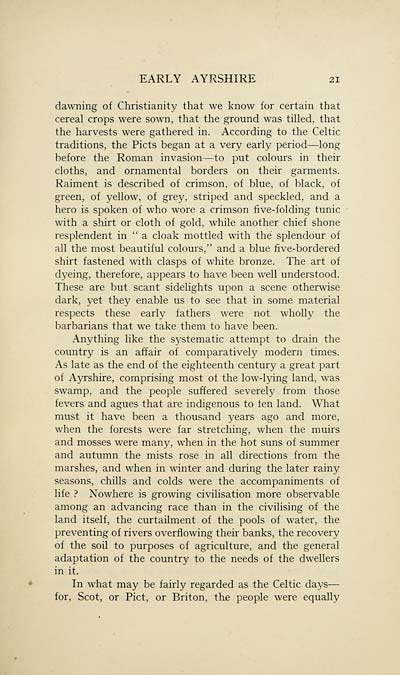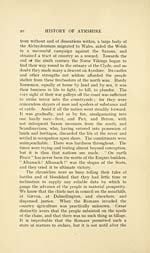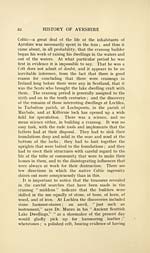Download files
Complete book:
Individual page:
Thumbnail gallery: Grid view | List view

EARLY AYRSHIRE 21
dawning of Christianity that we know for certain that
cereal crops were sown, that the ground was tilled, that
the harvests were gathered in. According to the Celtic
traditions, the Picts began at a very early period — long
before the Roman invasion — to put colours in their
cloths, and ornamental borders on their garments.
Raiment is described of crimson, of blue, of black, of
green, of yellow, of grey, striped and speckled, and a
hero is spoken of who wore a crimson five-folding tunic
with a shirt or cloth of gold, while another chief shone
resplendent in " a cloak mottled with the splendour of
all the most beautiful colours," and a blue five-bordered
shirt fastened with clasps of white bronze. The art of
dyeing, therefore, appears to have been well understood.
These are but scant sidelights upon a scene otherwise
dark, yet they enable us to see that in some material
respects these early fathers were not wholly the
barbarians that we take them to have been.
Anything like the systematic attempt to drain the
country is an affair of comparatively modern times.
As late as the end of the eighteenth century a great part
of Ayrshire, comprising most of the low-lying land, was
swamp, and the people suffered severely from those
fevers and agues that are indigenous to ten land. What
must it have been a thousand years ago and more,
when the forests were far stretching, when the muirs
and mosses were many, when in the hot suns of summer
and autumn the mists rose in all directions from the
marshes, and when in winter and during the later rainy
seasons, chills and colds were the accompaniments of
life ? Nowhere is growing civilisation more observable
among an advancing race than in the civilising of the
land itself, the curtailment of the pools of water, the
preventing of rivers overflowing their banks, the recovery
of the soil to purposes of agriculture, and the general
adaptation of the country to the needs of the dwellers
in it.
In what may be fairly regarded as the Celtic days —
for, Scot, or Pict, or Briton, the people were equally
dawning of Christianity that we know for certain that
cereal crops were sown, that the ground was tilled, that
the harvests were gathered in. According to the Celtic
traditions, the Picts began at a very early period — long
before the Roman invasion — to put colours in their
cloths, and ornamental borders on their garments.
Raiment is described of crimson, of blue, of black, of
green, of yellow, of grey, striped and speckled, and a
hero is spoken of who wore a crimson five-folding tunic
with a shirt or cloth of gold, while another chief shone
resplendent in " a cloak mottled with the splendour of
all the most beautiful colours," and a blue five-bordered
shirt fastened with clasps of white bronze. The art of
dyeing, therefore, appears to have been well understood.
These are but scant sidelights upon a scene otherwise
dark, yet they enable us to see that in some material
respects these early fathers were not wholly the
barbarians that we take them to have been.
Anything like the systematic attempt to drain the
country is an affair of comparatively modern times.
As late as the end of the eighteenth century a great part
of Ayrshire, comprising most of the low-lying land, was
swamp, and the people suffered severely from those
fevers and agues that are indigenous to ten land. What
must it have been a thousand years ago and more,
when the forests were far stretching, when the muirs
and mosses were many, when in the hot suns of summer
and autumn the mists rose in all directions from the
marshes, and when in winter and during the later rainy
seasons, chills and colds were the accompaniments of
life ? Nowhere is growing civilisation more observable
among an advancing race than in the civilising of the
land itself, the curtailment of the pools of water, the
preventing of rivers overflowing their banks, the recovery
of the soil to purposes of agriculture, and the general
adaptation of the country to the needs of the dwellers
in it.
In what may be fairly regarded as the Celtic days —
for, Scot, or Pict, or Briton, the people were equally
Set display mode to:
![]() Universal Viewer |
Universal Viewer | ![]() Mirador |
Large image | Transcription
Mirador |
Large image | Transcription
Images and transcriptions on this page, including medium image downloads, may be used under the Creative Commons Attribution 4.0 International Licence unless otherwise stated. ![]()
| Histories of Scottish families > Ayrshire > Volume 1 > (31) Page 21 |
|---|
| Permanent URL | https://digital.nls.uk/95194658 |
|---|
| Attribution and copyright: |
|
|---|
| Description | A selection of almost 400 printed items relating to the history of Scottish families, mostly dating from the 19th and early 20th centuries. Includes memoirs, genealogies and clan histories, with a few produced by emigrant families. The earliest family history goes back to AD 916. |
|---|

